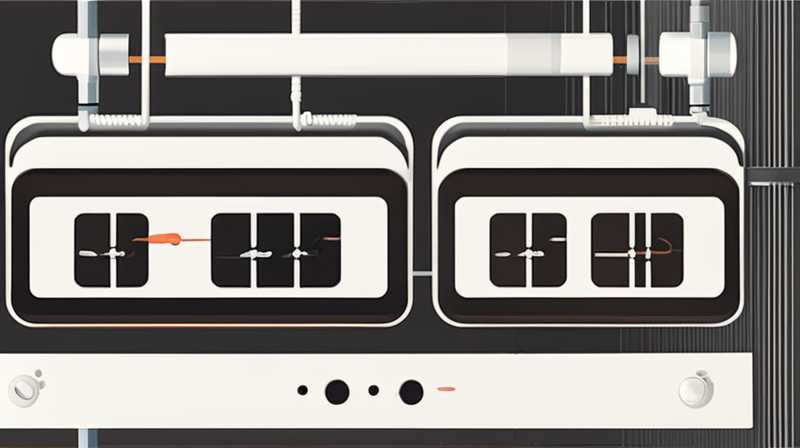
If the solar drain pipe does not empty, immediate attention is essential to prevent potential water damage or further complications. 1. Inspect for Blockages, check the pipe for any obstructions that may impede drainage. 2. Clean the Pipe, utilizing appropriate tools or agents to remove debris that could be causing the backup. 3. Evaluate Installation, ensuring that the solar system’s setup aligns with manufacturer guidelines for optimal performance. 4. Seek Professional Help, consider enlisting a qualified technician if the problem persists after initial troubleshooting. A deep dive into these aspects can ensure a prompt resolution to the issue of non-empty solar drain pipes.
1. INSPECT FOR BLOCKAGES
Identifying blockages within the solar drain pipe is a critical first step when faced with this issue. Over time, debris, leaves, or sediment may accumulate, obstructing the flow of water. A visual inspection can reveal any noticeable obstructions. If the blockage is visible, removal may be straightforward; however, if it lies deeper within the pipe, specialized tools might be necessary.
For a thorough examination, using a camera inspection can provide insight into areas that are not easily accessible. This technology enables the owner to analyze the interior of the pipe, pinpointing locations of concern without extensive disassembly. Furthermore, this step provides peace of mind, helping to ascertain whether the problem is localized or indicative of a broader issue with the drainage system. Regular maintenance can significantly minimize such blockages, ensuring the system operates efficiently.
2. CLEAN THE PIPE
Once any blockages are identified, the next logical action involves cleaning the pipe. Tools such as plumbing snakes or high-pressure water jets can be employed to clear stubborn debris. In cases where the buildup contains organic material or grease, specialized enzymatic cleaners could effectively break down these substances.
Moreover, consistent cleaning practices contribute to the longevity of the solar drainage system. Incorporating routine maintenance schedules can facilitate the early detection of any potential problems, reducing the likelihood of significant drainage issues developing in the future. Additionally, considering the use of filters or protective grates can help minimize debris entering the system altogether, creating long-lasting solutions that promote optimal performance.
3. EVALUATE INSTALLATION
Examining the installation of the solar system can reveal whether improper setup contributes to drainage issues. A tilt that is too steep or inadequate pipe sizing may hinder effective water flow. Review manufacturer instructions to ensure adherence to all guidelines concerning slope, pipe diameter, and fixture placement.
Furthermore, factors like the type of solar panel system and its relationship with the drainage mechanisms play a pivotal role. If components are installed incorrectly, addressing these installation flaws early prevents more severe complications, such as system inefficiencies or water pooling, which may lead to further structural damages. Regular audits can ensure that both the solar panels and drainage systems perform collaboratively as designed.
4. SEEK PROFESSIONAL HELP
Should initial troubleshooting methods fail to resolve the issue, enlisting professional assistance is advised. Trained technicians possess the expertise required for deep-seated complications that may complicate the basic problem. They utilize advanced diagnostic tools capable of identifying even the most elusive blockages or installation errors.
Moreover, professionals can extend guidance on maintenance practices that enhance evaporative efficiency, promoting a healthier drainage system. Utilizing their skills helps optimize the entire solar system’s performance, ensuring that all components work harmoniously. Investing in professional care often leads to long-term savings by preventing costly repairs from neglecting smaller issues.
FREQUENTLY ASKED QUESTIONS
WHAT CAUSES BLOCKAGES IN A SOLAR DRAIN PIPE?
Blockages within a solar drain pipe can arise from multiple factors. Debris such as leaves, algae growth, or sediment buildup commonly accumulates due to environmental conditions and the location of the solar system. In areas with heavy rainfall or strong winds, detritus can be swept into the drainage system, obstructing flow. Organic matter may further deteriorate, leading to clogs.
Another contributor can be poor installation practices. If the system lacks appropriate slope or if pipes are incorrectly sized, the likelihood of standing water increases, fostering conditions ripe for blockages. Regular inspections and maintenance can help mitigate these issues and preserve the efficacy of solar drain systems.
HOW CAN I MAINTAIN MY SOLAR DRAIN PIPE?
Maintaining a solar drain pipe involves consistent monitoring and proactive care. Begin by inspecting the pipe visually for any signs of buildup or blockages. This can be conducted at regular intervals, particularly before and after seasonal changes. Additionally, employing tools such as plumbing snakes every few months can prevent the accumulation of blockages.
Cleaning solutions can be utilized to eliminate organic material and grease that naturally accumulate over time. Establishing a maintenance schedule can also assist in keeping the pipe free-flowing, reducing the risk of significant problems in the long run. Furthermore, consider incorporating protective measures like filters at the pipe’s inlet to minimize debris entry, effectively prolonging the system’s lifespan.
WHEN SHOULD I CALL A PROFESSIONAL FOR SOLAR DRAIN ISSUES?
The decision to call in a professional technician should be made when maintenance efforts fail to resolve recurring drainage issues. If inspections reveal persistent blockages or if the drainage system appears to be functioning inadequately despite cleaning efforts, engaging an expert is prudent.
Additional red flags warranting professional intervention include visible damages to the drainage system, signs of water pooling, or deteriorating materials surrounding the solar panels. A trained technician can provide a thorough evaluation, ensuring that no underlying issues are overlooked. Ideally, maintaining communication with a professional not only addresses immediate concerns but can also establish a long-term maintenance plan, promoting the solar system’s efficiency.
Effective management of solar drain pipe issues hinges on timely inspections, regular cleaning, rigorous evaluation, and professional insights. Active participation in maintenance results in a more efficient system, safeguarding your investment against damage and promoting its longevity. By recognizing the importance of these steps, individuals can take charge of their solar energy solutions, ensuring they reap the maximum benefits throughout the years.
Original article by NenPower, If reposted, please credit the source: https://nenpower.com/blog/what-to-do-if-the-solar-drain-pipe-is-not-empty/


